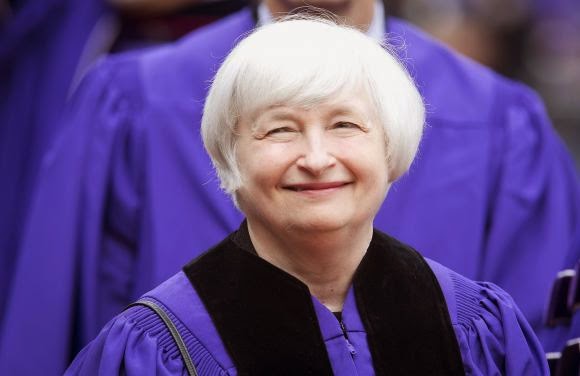 |
| Federal Reserve Chair Janet Yellen arrives to receive her honorary doctorate degree from New York University (NYU) at Yankee Stadium in the Bronx borough of New York May 21, 2014. |
Given the lack of drama, all eyes will be focused on whether officials tip their hand on longer-term plans for interest rates.
Policymakers, including new Fed Vice Chair Stanley Fischer, will release updated projections for the economy and for when they think rates should finally rise from near zero. They could also surprise investors with more detail on how they plan to eventually shrink the U.S. central bank's swollen balance sheet.
The policy-making Federal Open Market Committee (FOMC) kicked off its meeting Tuesday at 10 a.m. Eastern (1400 GMT) with a special discussion on the mechanics of how to raise rates when the time comes, jointly with the Fed's Board of Governors.
Here are the key things to watch in the policy statement and economic projections, which will be released on Wednesday at 2 p.m. (1800 GMT), and in a news conference by Fed Chair Janet Yellen that will start a half hour later:
* Is the Fed more upbeat on employment and inflation?
The economy has bounced back from a tough winter. More than 200,000 jobs were added in each of the last four months, lifting U.S. employment to its pre-recession peak; inflation has firmed slightly though it's still well below the Fed's 2-percent goal.
With unemployment now at 6.3 percent, officials will likely lower their estimates of the jobless rate for this year and next from March expectations of 6.1-6.3 percent and 5.6-5.9 percent, respectively. They could also nudge up their 2014 inflation forecasts from about 1.5 percent, while cutting their GDP forecast to take into account a dismal first quarter. Taken together, the forecast shifts would suggest the time for a rate hike is moving closer. * Where are rates seen in 2015 and the years ahead? The individual policymakers' expectations, known as the "dots" charts, will reveal whether they still see rates rising in 2015 and hitting 1 percent, on average, by year's end. Perhaps more intriguing is whether they continue to lower views on where the federal funds rate should settle in the longer-term. In March, the median expectation for the neutral federal funds rate was still 4 percent, but policymakers' dots have recently been edging lower, suggesting rates will not rise as sharply in the years ahead. The addition to the FOMC of Fischer, who is seen as a dove, as well as new Cleveland Fed President Loretta Mester, seen as a pragmatist, could diminish the influence of hawkish officials anxious to tighten policy. Lael Brainard was sworn in as a Fed governor on Monday - too late to submit forecasts. * Does Yellen show her hand? In her first news conference as chair in March, Yellen knocked the wind out of financial markets when she said the Fed could raise rates about six months after the asset purchases end in the fall. This week, investors will listen for any fresh hints on the rate-hike path.
Yellen has emphasized lingering problems of high long-term unemployment and too many part-time workers. But if she also stresses the need to regain some policy flexibility with a small rate rise, financial markets could respond.
She could also weigh in on when the Fed should halt reinvestments on maturing assets to let its balance sheet start to shrink.
v * Any wildcards?
The Fed's measured reductions in bond-buying sets it up to announce the end of the program in either October or December; it could telegraph the end date this week.
Longer term, the central bank could formally redefine its strategy for returning to a normal policy stance and shrinking its nearly $4.5 trillion balance sheet. The principles were last published exactly three years ago but have grown stale.
Another long shot is an announcement that the Fed has formally adopted a tool now being tested, called an overnight reverse repurchase agreement facility, that could help it drain reserves from financial firms when the time comes to raise rates. The repo tool was likely a focus of the Tuesday morning meeting on medium-term monetary policy.
(Reporting by Jonathan Spicer; Editing by Meredith Mazzilli)